Snorkeling and being amongst sea life in their natural environment is an awful lot of fun and extremely rewarding – if you’re going to take photographs while enjoying it you will want the best underwater camera for snorkeling that you can afford.
Taking photos and videos to share your experience and passion with friends and family makes sense right? Beats those common zoo photos hands down in my opinion.
So what camera do you need?
Finding a camera to use for snorkeling is a whole lot different to finding a camera for scuba-diving. For the latter you need a high end (read expensive) DSLR r mirrorless camera with a waterproof housing.
Snorkeling depths are determined by how long you can hold your breath before needing to come up for more air, divers take their air with them and can go much deeper.
So let’s first look at what you need to look for in an underwater camera specifically for snorkeling and then we’ll move on to the best camera for the job.
You’ll find some of the cameras featured here also feature in my best point and shoot camera review – if it is versatility you want be sure to read that post too.
Contents
What to Look For in Your Snorkeling Camera
We are all different and have different needs so you need to ask yourself a few questions:
- How often do you snorkel?
If you aren’t sure or are going on a one time only snorkel then hiring may be a more cost effective option. - How deep will you go?
Underwater cameras suitable for snorkelling are generally rated to a maximum depth of 10 meters. - How good do you want your photos and video quality to be?
Will you settle for straight out of camera Jpegs or would RAW photos that you can process be more your thing? Megapixels count. - How strong does the built in flash need to be? Although snorkeling photography occurs in shallow waters where sunlight still penetrates a built-in flash is a must. Your requirements will depend on the time of day you snorkel, the weather you snorkel in and the water conditions.
- What is Your Budget?
Yes this plays a part despite what others say about your money. - Budget and basics settled – do you want any extra bells and whistles?
Things like built in GPS, WiFi or BlueTooth transferability etc.
Goat Island Marine Reserve is a short drive from where I live.
It’s a snorkeler’s paradise and one of many such reserves to be found around New Zealand’s extensive and interesting coast line – come and visit us
The Best Underwater Camera For Snorkeling - 5 top picks
Please note these cameras are not suitable for diving to depths below their underwater rated depth and, although waterproof to these depths, care still needs to be taken before and after submersing them.
- Before submersing ensure all opening flaps (battery, memory card etc) are securely closed.
- After use and before opening thoroughly dry the outside of the camera before opening any compartments.
- See “caring for your snorkeling camera” further down.
Olympus Tough TG-6
Technical Specifications
Customer rating: 4.3/5 (86%)
Megapixels: 12 MP
Sensor: High Speed BSI CMOS with improved low light performance
Processor: TruePic VIII image processor
Maximum Burst Speed: 20 Frames per second (fps)
Waterproof Rated Depth: 15 Meters (50 feet)
Minimum Operating temperature: 14°F (-10°C)
Zoom factor: 2x Digital, 4x Optical zoom
Lens Specs: High speed anti-fog lens f2.0 – 4.9
ISO Range: Auto 100 – 1600 expandable to 100 – 12,800
Video Capabilities: Ultra HD, 4K at 30fps
Memory: SD / SDHC / SDXC (recommend at least 64GB for both video and photos)
Supports RAW Format: Yes
Other Features:
Dust proof, crushproof to 220lbs/f (100KG/f), shock proof from a height of 7 feet (2.1meters), Wifi, GPS, Manometer, Compass and temperature sensors.
Best for:
#1 Choice for all enthusiast and serious snorkelers who dive up to 15 meters in depth
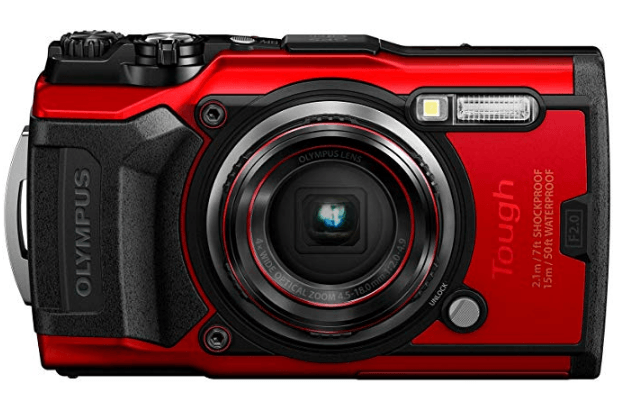
Pros
- Comes in black or red
- Can be used for taking photos at depths of up to 45 meters when coupled with the Olympus PT-059 underwater housing
- 5 underwater shooting modes – macro, wide, snapshot, microscope and HDR
- 3 Underwater white balance modes specifically designed for underwater photography
- 12MP high speed sensor ensure tack-sharp photos every time
- Exceptional detail in the 4K UHD video with true colours
- Outstanding macro photo capabilities – ideal for coral reefs and smaller subjects, the microscope option allows for shooting as close as 1cm
- Shoot up to an incredible 20fps
- Ideal for low light conditions
Cons
- Default settings don’t produce the best results. For best results shoot in RAW and one of the manual modes
- Does not come with a lens cover – who knows why Olympus decided this was a good idea
Nikon Coolpix W300
Technical Specifications
Customer rating: 4.2/5 (84%)
Megapixels: 16MP
Sensor: BSI CMOS Low Light Sensor
Processor: Expeed C2
Maximum Burst Speed: 7.5 fps
Waterproof Rated Depth: 30 meters (100 feet)
Minimum Operating temperature: -10°C (14° F)
Zoom factor: 5 X Optical with Hybrid Vibration Reduction
Lens Specs: f2.8 – 4.9
ISO Range: 125 – 6400
Video Capabilities: 4K Full HD
Memory: SD / SDHC / SDXC Recommend using 64GB of class 6 or higher
Supports RAW Format: No
Other Features:
Built in WiFI, bluetooth, built-in GPS, eCompass, depth gauge and altimeter.
Dust proof and shock proof to 2.4 meters (8 feet)
Best for: All snorkelers and in particular those who dive to deeper depths
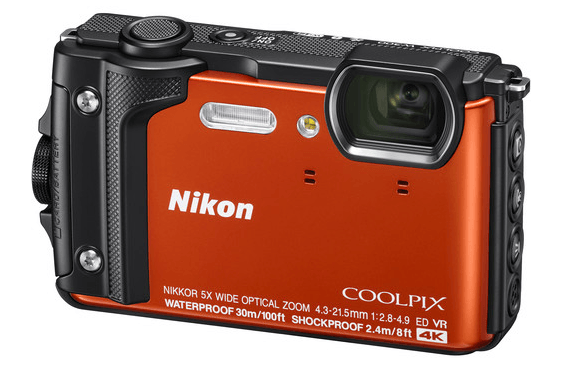
Pros
- Designed and built for action
- Simple and fast access to buttons
- Uncluttered controls on body
- Excellent Macro capabilities up to 1cm
- Snapbridge technology for fast transferring of files
- Timelapse recording
- A great all rounder if you are happy to shoot jpegs (the plus side of that is that there is no processing involved)
Cons
- Why oh why no option to shoot RAW?
FujiFilm FINEPIX XP140
Technical Specifications
Customer rating: 4.1/5 (82%)
Megapixels: 16 MP
Sensor: BSI CMOS
Processor: CMOS Shift optical image stabilisation
Maximum Burst Speed: 10 fps
Waterproof Rated Depth: 25 meters (80 feet)
Minimum Operating temperature: -10 ° C (14° F)
Zoom factor: 5 x optical zoom
Lens Specs: 5mm – 25mm (28 mm – 140 mm equivalent on 35mm) f3.9 – 4.9
ISO Range: 100 – 6400 (can be extended to 12,800)
Video Capabilities: 4k, Full HD @ 15p
Memory: SD / SDHC / SDXC plus internal memory of approximately 90GB
Supports RAW Format: No
Other Features:
Shockproof to 1.75 Meters (5.8 feet), dust-proof, time-lapse, bluetooth and limited WiFi transferability.
Best for:
Family holidays where everyone can get to use this very easily drivable and extremely rugged little camera.
Those on a low budget
One-off snorkeling holiday
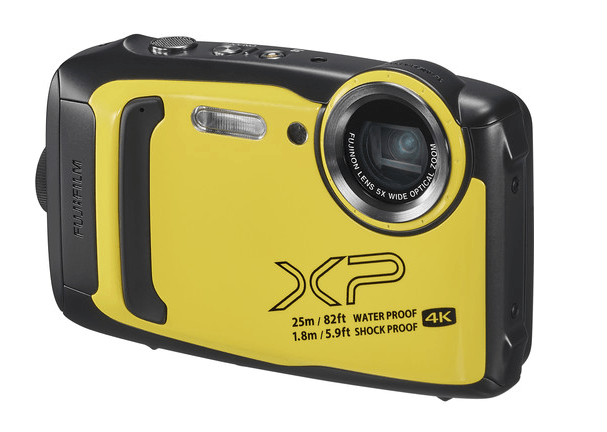
Pros
- Comes in 5 colours
- Excellent value for money
- Simple to use
- Very rugged
Cons
- No Raw option
- Full HD video at a limiting 15P
RICOH WG - 60
Technical Specifications
Customer rating: 3.9/5 (78%)
Megapixels: 16 MP
Sensor: BSI CMOS
Processor: Digital image stabilisation
Maximum Burst Speed: 1.08 frames per sec for 69 frames
Waterproof Rated Depth: 45.9 feet (14 meters)
Minimum Operating temperature: -10° c
Zoom factor: 5 x Optical zoom
Lens Specs: 5 – 25mm f3.5 – 5.5 (28 – 140mm 35mm equivalent)
ISO Range: 125 – 6400
Video Capabilities: Full HD 1080p
Memory: SD/SDHC/SDXC cards plus 68 GB internal memory
Supports RAW Format: No
Other Features:
Built-in macro ring lights
25 scene modes including underwater and underwater movie mode
Shock-proof up to 1.6 m (5.2 ft) and crush-proof up to 100kgf
Dust-proof
Time lapse capable
Best For:
Those on a low budget
Family outings where the whole family can easily use it
Great for Kids
Pocket point and shoot for every day use and great for hiking
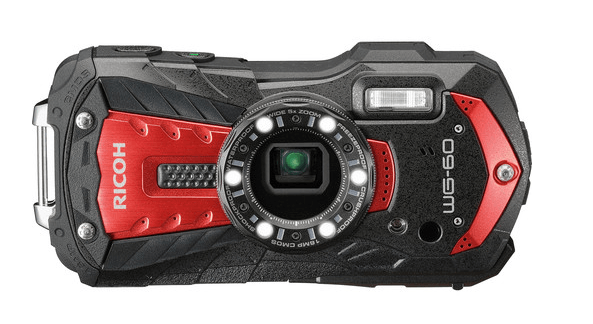
Pros
- Useful built-in ring lights
- A neat reliable point and shoot camera
- Simple controls – easy to handle
- Solidly built to withstand even the roughest handling
- Great Value for money
Cons
- No Wireless, Bluetooth or GPS
- Does not support RAW format – restricted to Jpegs (plus side is it saves on post processing)
Nikon Coolpix W150
Technical Specifications
Customer rating: 4.5/5 (90%)
Megapixels: 13 MP
Sensor: CMOS
Processor: Built-in electronic vibration reduction
Maximum Burst Speed: Zero
Waterproof Rated Depth: 10 meters (33 feet)
Minimum Operating temperature: -10C (14°F)
Zoom factor: 3 x Optical Zoom
Lens Specs: 4.1 – 12.33mm (30 – 90mm 35mm equivalent)
ISO Range: 125 – 1600
Video Capabilities: Full HD 1080p30
Memory: Single slot for SD/SDHC/SDXC cards
Supports RAW Format: No
Other Features:
SnapBridge technology with built-in WiFi and Bluetooth
Built in 2 stop neutral density filter for ultra bright conditions
Shock-proof to 1.9 meters (5’9″), Dust-proof
18 Scene modes to choose from
Best For:
Casual holiday snorkeler with family that can all use the camera
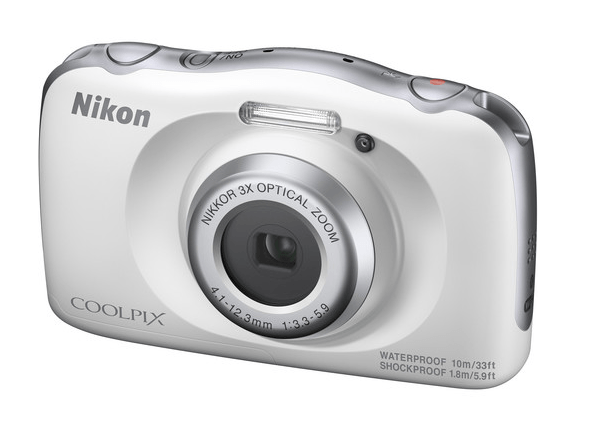
Pros
- The built in ND filter is a useful feature for very bright scenes
- dedicated underwater features such as face framing and underwater clarity adjustments
- In camera editing
- 29 Minutes of recording
- Durable and well built
Cons
- Does not support RAW format shooting
- No time lapse recording
Two Inexpensive Models Worth Considering
Want something inexpensive but reliable and trustworthy for that snorkeling trip?
Try one of these two popular models.
Digital Waterproof Camera
Under $80.00 – learn more about it.
AKASO DVD Camcorder
Around $60.00 – learn more about it.
Caring For Your Snorkeling Camera
Perhaps more than any othr camera special attention to drying and storing your camera after each use.
Just because the camera is watersealed does not mean you should not give it a complete and thorough wipe down after each use.
I would suggest the following for getting the most out of your camera for many years to come.
- After each use give it a thorough rinse in fresh water to get rid of any salts. I’m very weary of salt water which is extremely corrosive and for me and my photography gear “rather safe than sorry” is my motto.
- Give it a thorough going over with a clean dry cloth (changing cloths if you need to) until it is completely dry.
- Give it a blow dry with a hair dryer. Set the dryer to normal and not hot or warm.
- Store in a cool dry area that has constant temperature and, if possible, constant humidity – a camera dry cabinet is ideal.
To summarise get the salt water off the camera and thoroughly dry before storing in a cool dry area.
Final Word on Selecting a Camera for Snorkeling
Snorkeling is one of those unusual sports that require no special skill set – only that you can swim.
With a pair of googles and flippers you can explore the fascinating underworld life that abounds close to shore. If you live on the coast you will appreciate the freedom snorkeling gives you.
It’s a great pasttime that the whole family can join in on. It’s a great way to educate yourself and your children on the abundant sea life that our oceans have to offer.
And like all family gatherings this is an excellent time to record special moments.
As can be seen from the list of underwater cameras ideal for snorkeling listed here the cameras are incredibly inexpensive and yet produce great quality images. Images that are memories of special family or personal time.
And what’s more all the cameras listed here can be used out of the water making them a sound investment.
My pick of the bunch would be the Olympus Tough TG-6.
Let me know in the comments below what your thoughts are and which of the cameras you would choose.
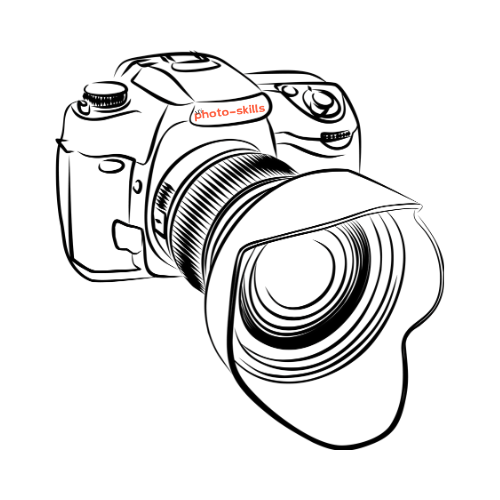
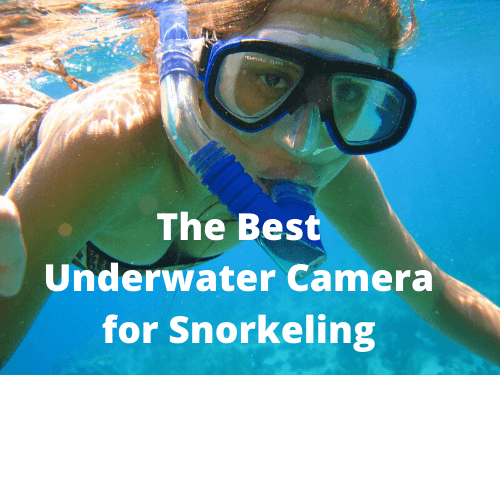

Lawrence,
One of my fondest memories was the time I went snorkeling on my Hawaiian vacation. You are so right…seeing all that life up close was amazing. I didn’t have a camera with me so I am not able to share that experience with my friends. This article would have been very helpful. You have given us so many choices with great detail. I don’t plan on doing any water activities in the future (health issues) but this is useful information for any camera purchase. Your recommendation would be the one I choose. So thankful for the photos of other adventurers. I feel like I’m sharing the experience with them. With the right equipment, one can maximize the results. Thank you for the information.
All the best,
Debbie
Hi Debbie,
Thanks for your lovely comments and sorry to hear about the health issues.
It struck me when I read that you could no longer snorkel that one of the responsibilities we have as a photographer is to be able to take photos to share with others who are unable to see things for themselves.
In your case that is snorkeling and the underwater world, for others it may be scenes from snow covered mountains, landscapes from countries they are unable to visit, wildlife they will never get to see, weddings and family occasions they cannot attend, history they weren’t part of.
The list goes on and on and I love looking at photos for this reason – it’s like living it and being there.
Thanks once again for dropping by and commenting and all the best with your health.
Lawrence
I can’t swim so snorkeling is out of the question for me as is taking pics underwater. I have wondered in the past about the kinds of cameras divers do use, especially after watching documentaries about water-based life and deep water exploration.
The cameras you list – are they general cameras that just happen to be usable underwater at relatively low depths?
Do you have any opinion on the cheaper HD 1080P 4MP and 16 MP 4K Cameras that seem to come from China and are claimed to work to depths of 30 metres or more?
Cheers,
Gary
Hi Gary
Thanks for your comment.
The listed cameras are general point-and-shoot cameras that can be used on land and underwater to the depths stated. I don’t think they were specifically designed for snorkelling, not in the beginning anyway, but there is now a big market for them.
Cameras and videos, like verything else, will continue to evolve and I am pretty sure the newer, more advanced models (regardless of where they are made) eill continue to improve beyond recognition. But like everything else their popularity and ongoing production will ultimately be dictated by demand.
Waterproofing a camera is an expensive exercise and it will be interesting to see how far these evolve.
The next step will probably be a smart phone that is waterproof up to 30 meters – but who knows?
Thanks for your comment.
Sincerely
Lawrence